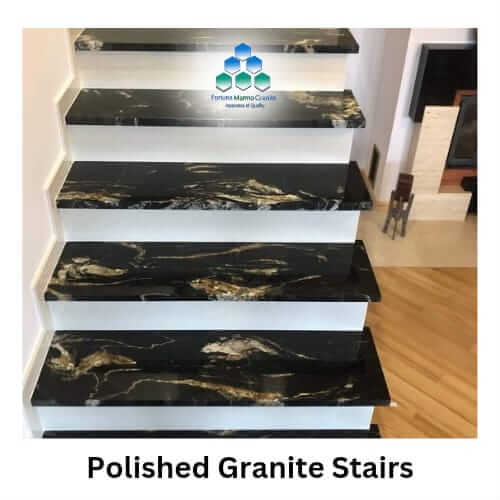Granite Staircases: A Timeless Investment for Your Home
Flamed Granite Steps
Flamed granite steps provide a textured finish that significantly enhances slip resistance. This makes them an ideal choice for outdoor staircases where safety is a primary concern. The flamed finish is achieved by exposing the granite to high temperatures, causing the surface to burst and create a rough texture.
This process not only adds to the safety features but also gives the stone a rustic and natural look.
Benefits of Flamed Granite Steps:
- Excellent slip resistance
- Weather durability
- Rustic appearance
Polished Granite Steps
Polished granite steps create a sleek and elegant appearance, perfect for indoor settings or high-end designs. Although, The polished finish brings out the natural beauty of the stone, highlighting its intricate patterns and vibrant colors. However, it's essential to note that polished surfaces can be slippery when wet.
Benefits of Polished Granite Steps:
- High aesthetic appeal
- Smooth surface
- Easy to clean
Black Granite Staircase
Granite steps and risers come in a variety of colors such as black, white, and brown. Although, This range allows homeowners to customize their staircase design to match any architectural style or interior decor. Consequently, Black granite offers a bold and sophisticated look. It's often used in modern and contemporary designs due to its dramatic appearance.
Moreover, Granite steps come in various finishes and styles, making them a versatile choice for both indoor and outdoor staircases. Each type offers unique characteristics that cater to different aesthetic preferences and functional needs.
In addition, By choosing granite for your stairs, you combine durability, low maintenance requirements, and aesthetic appeal into one timeless investment.
White Granite Staircase
White granite provides a clean and timeless look. It's versatile enough to fit into both traditional and modern settings.
Brown Granite Staircase
Brown granite offers a warm and earthy tone. It's an excellent choice for creating a cozy and inviting atmosphere.
Safety Considerations with Granite Staircases
- Flamed Finishes
This finish creates a rough texture by applying high heat to the granite surface. The result is an anti-slip surface ideal for external use, ensuring safety without compromising on durability or style.
Incorporating these features into your granite staircase design not only enhances safety but also maintains the visual appeal that granite naturally offers.
Best Practices for Installing Granite Steps
Professional installation plays a crucial role in ensuring the longevity and safety of granite staircases. A skilled installer ensures that the steps are accurately aligned, properly supported, and securely anchored. This minimizes the risk of shifting or settling over time, which can lead to cracks or uneven surfaces.
Common Mistakes to Avoid
- Inadequate Substrate Preparation: The foundation must be stable and level to prevent future issues. Any unevenness can cause the granite steps to crack or become misaligned.
- Improper Measurement: Accurate measurements are essential. Miscalculations can lead to gaps or overhangs that not only look unsightly but also pose tripping hazards.
3.Incorrect Adhesive Use: Using the wrong type of adhesive can compromise the integrity of the installation process. Always opt for adhesives specifically designed for stone installations.
4.Ignoring Expansion Joints: Granite expands and contracts with temperature changes. Failing to incorporate expansion joints can result in cracks.
Installation Tips
- Always hire a professional with experience in stone installations.
- Ensure that all measurements are double-checked before cutting.
- Use high-quality materials designed for granite.
- Follow manufacturer guidelines for adhesive and sealant application.
By adhering to these best practices, you significantly enhance both the durability and aesthetic appeal of your granite staircases, making them a worthwhile investment for your home.
Cost Factors to Consider When Choosing Granite for Your Staircase
1.Size and Scope:
Larger staircases naturally require more material, increasing the overall cost. Project dimensions affect costs.
2.Type of Granite:
Different types of granite, such as lapotra granite, vary in price.High-end options cost more for their unique patterns and colors.
3.Finish and Customization: Polished, honed, flamed, or leathered finishes each have different price points. Customizations may increase cost.
4.Installation Complexity: More intricate designs and complex installations can escalate labor costs. The difficulty of installation can significantly impact labor costs.
Maintenance Tips to Keep Your Granite Staircase Looking Its Best
- Regular Cleaning: Moreover, Use water and a mild detergent to clean your granite steps. Avoid harsh chemicals that could damage the stone's surface.
- Stain Prevention: In addition, Wipe up spills immediately to prevent staining. Granite is resilient but can still absorb substances if left unattended.
- Sealing: Although, Apply a granite sealer periodically to maintain the stone's resistance to stains and moisture. Frequency depends on foot traffic and exposure to elements.
- Inspection: Consequently, Regularly check for any signs of wear or damage. Early detection can help address issues before they escalate.
Conclusion
In conclusion, granite staircases from Fortuna Marmo Granite are a timeless investment that enhances your home's beauty and value. In addition, Their durability ensures long-lasting performance, while the unique patterns add a touch of elegance. Choose granite staircases to create a stunning focal point in your home that will stand the test of time.




